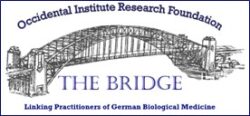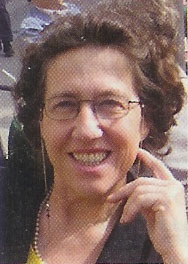Hops and Cocoa Against Cancer and Allergies
Targeted Help with Orthomolecular Therapy
Orthomolecular cancer therapy gains greater and greater insights into the complex processes of the body. With gentle medications it succeeds in creeping into the immune system to help the body in the removal of tumor cells. The physician Juliane Sacher introduces new insights.

Everything we know about present day chronic diseases is that they deal with our environment, our nutrition and our behavior.
Cancer itself is a prosperity disease – even if this is denied over and over again. Erroneously from that fact you assume the cause of a tumor illness originates in the cell nucleus. The cell should change in the direction of a tumor cell by genetic mutations. You recognize these tumor cells by the changed surface receptors. Actually during recent years these have also been shown more and more by laboratory examinations. School [conventional] medicine assumes from this fact that the cause is a mutation of unknown genesis.
A crucial counter-evidence of this official cancer formation theory is the experiment with the cell nucleus transplantation of a very malignant mouse tumor cell into a healthy newly fertilized ovum of a healthy mouse from which you have removed the healthy nucleus. According to the official theory a tumor would have to develop.
This experiment was carried out several times during the 1980’s and a tumor never developed, instead healthy mice and healthy descendants always developed.
The Power of Nutrients
Therefore, this means that something must be in the healthy cell plasma which has an influence on the diseased cell nucleus and that the diseased cell nucleus can again become healthy.
This experiment fits very well with the thesis of Prof. Otto Heinrich Warburg, who saw the cause of cancer as a disturbance of the respiratory chains. A disturbance of the respiratory chains in the mitochondria breaks down the “cell nucleus monitoring function and it can develop exactly the above described disease making changes of the cell nucleus genes with the special surface receptors.” On the basis of the above mentioned findings you can then also effectively treat tumor diseases. Dr. Heinrich Kremer has written this in his book “Die stille Revolution der Krebs- und AIDS-Medizin” [The Quiet Revolution of Cancer and AIDS Medicine], where he refers to the findings from the official scientific literature.
Also Dr. Thomas Tallberg treated in this direction as an immunologist at the University in Helsinki for over 40 years, namely only with non-toxic food materials. He can look back on fantastic successes which he has also published several times in the “Deutschen Zeitschrift für Onkologie” – and finally in a large review article in 2003.
In recent years another researcher, Dr. Johannes Coy, passed on his experiences to the general public. He discovered a certain enzyme, the TKTL1 (Transketolase1) which is responsible for the “feeding” of tumor and metastatic cells with glucose (see “Krebs durch Adrenalinmangel” [Cancer through Adrenal Deficiency] in this Issue [of CO’MED]).
It makes sense to combine all non-toxic therapeutic approaches in a synergistic manner, so that the greatest possible benefit is gained for the patients:
- Redifferentiating according to Herinrich Kremer
- Nutrition without glucose, [but with] lactic acid and Tavarlin Oil according to Johannes Coy
- Amino acids and perhaps “Neurofood” according to Thomas Tallberg
Self-Protection through Cell Death
At the least we know that everything which promotes apoptosis, thus programmed cell death, contributes additionally to eliminating tumor cells.
In all tissues the renewal occurs constantly through cell division. Through damaging influences (environmental pollutants, tobacco smoke, different medications, etc.) increased formation of “mistakes” occur during cell division. To rid itself of these cells – and in fact without that inflammation reactions occur at the same time – nature has developed the so called “programmed suicide”, the apoptosis. If the apoptosis is smaller than the new formation of defective cells, then for example a tumor can originate.
The defective cells can be distinguished from healthy cells – just on the basis of their changed surface receptors – and thus can be recognized as foreign and can be removed through immune reactions. However tumor cells can develop strategies to escape the immune attack (Immune Escape Mechanism). The immune system is only narrowly suited to the elimination of tumor cells.
The Healing Power of Turmeric, Garlic and Ginger
A series of non-cytostatic active natural substances promote the apoptosis (Dorai, Aggarwal 2004, Taraphdar et al. 2001) like for example curcumin from turmeric, diallysulfide from garlic or 6-gingerol from ginger. You can use these substances as a preventative as well as supporting the healing process, which means you can additionally use them before and after tumor removal and even meaningfully during and after chemotherapy.
The Importance of the TH1-TH2 Balance
Immunologically we distinguish two completely different directions, the so called TH1 and the TH2-answer. Please see the box [below] as well as my articles in raum&zeit about AIDS:
- “AIDS – Chronolgie der Irrtümer” raum&zeit, No. 141 or “AIDS – The Chronology of a Mistake”, The Bridge, Vol. 3, Issue 1; Part 1
- “AIDS – Das Virus, das es nicht gibt”, raum&zeit, No. 142 or “AIDS – The Virus That Is Impossible”, The Bridge, Vol. 3, Issue 2; Part 2
- “AIDS – Wie alternative Therapien helfen können”, raum&zeit, No. 143 or “AIDS – How Alternative Therapies Can Help”, The Bridge, Vol. 3, Issue 3, Part 3
If the balance between the immunological TH1- and TH2-answer is disturbed in the direction of TH2, then a tumor development occurs more easily. The immunological TH1 direction promotes the elimination of tumor cells. Thus the goal with tumor patients is to reduce TH2 and to promote TH1. In this case the therapy corresponds with the treatment of other chronic TH2 diseases – AIDS, chronic intestinal diseases, allergies, asthma, tuberculosis, etc.

Garlic promotes the
formation of new cells.
In the graphics in Fig. 1 we see the different supporting and inhibiting mechanisms for the TH1 or TH2 reaction:

Fig. 1: Inhibiting and supporting effect of the different mechanisms of TH1-TH2 balance.[Cells à Transformation → Proliferation → Angiogenesis → Metastasizing. Immune – Escape – Mechanisms]
- Prostaglandin and leukotriene promote from both response paths of the TH2 modulated humoral path (Honma et al. 1998; Shinamura et al. 2001).
Prostaglandin also promotes the Immune-Escape-Mechanism (= Hide-and-Seek so that they are not tracked down by the immune system) as far up as to immune suppression (Cook 2002; Thun et al. 1993; Marnett 1992; Liu et al. 2001) and prostaglandin increases the aromatase activity, a source for estrogen production, which induces certain forms of breast cancer to increasingly expand. - The TH2 carrier substance plays a determining role in the hindrance of apoptosis.
Simultaneously with strengthening of the TH2-answer – production of IL-4, IL-5, IL-10 – the TH1-answer is regulated down. On the other hand, by strengthening the TH1 modulated answer the TH2 assorted cytokines IL-5, IL-4 and IL-10 are braked. - Tumors also tend toward the blood vessel neoplasm (angiogenesis) to get enough nutrients for further growth. In this stage an over expression (increased production) of the COX-2 enzymes occurs in the angiogenesis phase (Subbaramaiah, Dannenberg 2003). Furthermore, IL-10 is increasingly produced in this phase.
- Many tumor types are connected with higher values of IL-10 . IL-10 hinders apoptosis across a low permeability of the mitochondrial membrane (Perianayagam et al. 2005).
Materials from Hops, Wine Grapes and Cocoa
In Fig. 1 you also find the effect of both humulin and oligomeric proanthrocyanidin (OPC) substances. Both of these active plant substances are part of a mixture of single preparations currently on the market for one year. Humulin and proanthrocyanidin are introduced with silicon dioxide molecules as the carrier. As carrier materials these molecules are a drug delivery system (Gradl 2003), which allows very small quantities of active substances to work. Nevertheless, the particles are picked up in certain cells in the intestinal mucosa (M cells of the Peyer's Patches) directly into the monocytes and are transported by these to the place of application without the active substances being distributed in unnecessary amounts systemically into the body. Side effects are thus cancelled or are drastically reduced.
Now here are the individual components of the preparations and their differentiated effect:
Humulin – the bitter material of hops
- Specific inhibitor of cyclooxygenase-2 (COX-2) (Honma et al. 1998) thereby inhibiting the prostaglandin formation.
- Fat metabolism: arachidonic acid (originates from Omega-6) is converted by certain enzymes (COX-2) into inflammation substances (prostaglandin) and this prostaglandin leads to a reinforced TH2 reaction.
- Promotes apoptosis
- Hinders the angiogenesis of tumors (Shimamura et al. 2001)
- Can possibly cancel angiogenesis (Iniguez et al. 2003)
- Regulates the TH2-answer down
- Promotes permeability of the mitochondrial membrane (Tobe et al. 1997)
Oligomeric proanthrocyanidin (OPC) – from wine grapes or cocoa
- Inhibitor of lipoxygenase (LOX) (Holzhutter et al. 1997), thereby inhibition of the formation of leukotriene from arachidonic acid (see Fig. 2)
- Promotes apoptosis (Dorai, Aggarwal 2004, Taraphdar et al. 2001)
- Promotes the too weak immunological TH1 immune reaction by strengthening the T-killer cells into effective cells (Malina et al. 2000).
Oligouronic acids – from brown algae
Works as a phase transfer catalyst, in that it transfers oxygen to the cells catalytically (similar to hemoglobin) (Gradl, Maurer 2000).
The apoptosis is dependent on whether the mitochondrial membrane is permeable for cytochrome-C. If this is the case, the cytochrome-C is distributed into the plasma. It activates with it a cascade of enzymes, caspase, which first fragments the cell nucleus and finally prepares the cell nucleus fragments together with cytoplasm (apoptotic body) for removal by phagocytes. IL-5 inhibits the activation cascade of caspase.

Fig. 2: Effect of humulin and OPC on apoptosis
The closing of the mitochondrial membrane mainly serves for protection of the DNA of the mitochondria, which is not protected like the DNA of the cell nuclei by histone and which also possesses no repair genes like the cell nucleus DNA. However, this closing not only prevents apoptosis but with a longer [time of] existence also leads to a change over from aerobic respiration in the mitochrondia to anaerobic respiration in the cytoplasm over the pentose phosphate path, the well known Warburg phenomenon of tumor cells.
Without opening the mitochondrial membrane no apoptosis takes place. In Fig. 2 you see by which materials and mechanisms the permeability of the mitochondrial membrane is steered:
Supported by:
- Proapoptotic BAX, cytokine, which promotes apoptosis
- Humulin, which inhibits COX-2
- OPC which inhibits LOX
Inhibited by:
- bcl-2 and mcl-1
- COX-2 enzyme
- IL-10
- IL-5 which inhibits BAX (Dewson et al. 2001, Maccarone et al. 1997)
- As a result inhibits the activation cascade of the caspase
- Leukotriene, inhibits BAX and activates bcl-2 and mcl-1 (Tong et al. 2002)
The described connections explain why crucial active plant substances can promisingly be used prophylactically as well as with the existence of severe chronic diseases, including tumor diseases. A bigger study on breast cancer patients will begin soon on whom the described preparation will be tested.
TH1- TH2 Balance
The TH1 and TH2 cells show two kinds of T-Helper cells. They connect both immune systems in our bodies.
- The first immune system is the historically older evolution. It was already available to protozoans. The weapon here is nitrogen gas (NO-) which destroys foreign germs. This is produced by TH1 cells.
- More than 50 million years later at the level of the bony fish the second immune system developed which is even much longer well known by science.
For higher living beings it was additionally necessary to be able to develop antibodies that bind themselves to germs and foreign bodies and destroy them. TH2 cells help to produce antibodies.
For the destruction of tumor cells resistance to NO gas, as well as the TH1 reaction of the body, is very important. In the most favorable case the TH1 and TH2 reaction is in balance. People in whom this balance is tipped in the direction of TH2 reaction are threatened to develop a tumor.
In Part 1 , AIDS – The Chronology of a Mistake, Part 1
In Part 2, AIDS – The Virus That Is Impossible, Part 2
In Part 3, AIDS – How Alternative Therapies Can Help, Part 3
 An Exclusive Translated Article for Members
An Exclusive Translated Article for Members
From THE BRIDGE Newsletter of OIRF
Published June 2010
From an article in raum&zeit
Volume 26, Number 150, November/December 2007
Machine Translation by SYSTRAN, Lernout & Hauspie, LogoMedia & Promt
Translation & redaction by: Carolyn L. Winsor, OIRF
© Copyright 2007, Dr.med. Juliane Sacher, Frankfurt, Germany
Literature
- D’Amico, A.V.; McKenna, W.G.: .Apoptosis and a re-investigation of the biologic basis for cancer therapy”; Radiother. Oncol 33: 3-10 (1994)
- Dewson, G.; Cohen, G.M.; Wardlaw, A.J.: “lnterleukin-5 inhibits translocation of BAX to the mitochrondria, cytochrome c release, and activation of caspases in human eosinophiles”; Blood 98(7): 2239-2247 (2001)
- Fortis C.; Foppoli M.; Gianotti L.; et. al.: .”Increased Interleukin-10 serum levels in patients with solid tumors”; Cancer Lett. 104: 1-5 (1996)
- Gradl, T.; Maurer, S.: “Macro and trace elements as central cations in phase transfer catalysts and their biological meaning”; 20. Arbeitstagung Mengen- und Spurenelemente, Friedrich Schiller Universität Jena (2000)
- Gradl, T.: “Steuerung von Zytokinen bei Rheumatoider Arthritis durch Gewürze und Gewürzextrakte”; J. Orthomol. 11(3): 42-47 (2003)
- Honma, Y.; Tobe, H.; Makishima, M.; Yokoyama, A.; Okabe-Kado, J.: “lnduction of differentiation of myelogenous leukemia cells by humulone, a bitter in the hop”: Leuk. Res. 22(7): 605-610 (1998)
- Subbaramaiah, K.; Dannenberg, A.J.:“Cyclooxygenase-2: A molecular target for chemoprevention and treatment”; Trends Pharmaeol. Sci. 24: 96-102 (2003)
- Kremer, H.: “Die stille Revolution der Krebs- und AIDS- Medizin”, ehlers verlag gmbh, Wolfratshausen 2007
- Liu, CH.; Chang, S.H.; Narko, K.; Trifan, O.C.; Wu; M.T., Smith; E., Haudenschild, C.; Lane, T.F.; Hla, T.: “Overexpression of Cyclooxygenase (COX-2) is sufficient to induce tumorgenesis in transgenic mice”; J. Biol. Chem. 276 (21): 18563-18569 (2001)
- Maccarone, M.; Catani, M.V.; Agro, A.F.; Melino, G.: “Involvement of 5-lipoxygenase in programmed cell death of cancer cells”; Cell death & Diff. 4 (5): 396-402 (l997)
- Malina, K.; McCormick, K.; Kappagoda, T.: “Eftects of cocoa extracts on endothelium-dependent relaxation”; J. of Nutrition 130: 2105S-2108S (2000)
- Shimamura, M.; Hazato, T.; Ashino H., Yamamoto; , Iwasaki, E.; Tobe, H.; Yamamoto, K.; Yamamoto, S.: “Inhibition of angiogenesis by humulone, a bitter acid from beer hop”; Biochem. Biophys. Res. Commun. 289(1): 220-224 (2001)
- Taraphdar, A.K.; Roy, M.; Bhattacharya R.K.: “Natural products as inducers of apoptosis: implication for cancer therapy and prevention”; Curr. Sci. 80(11): 1387-1389 (2001)



